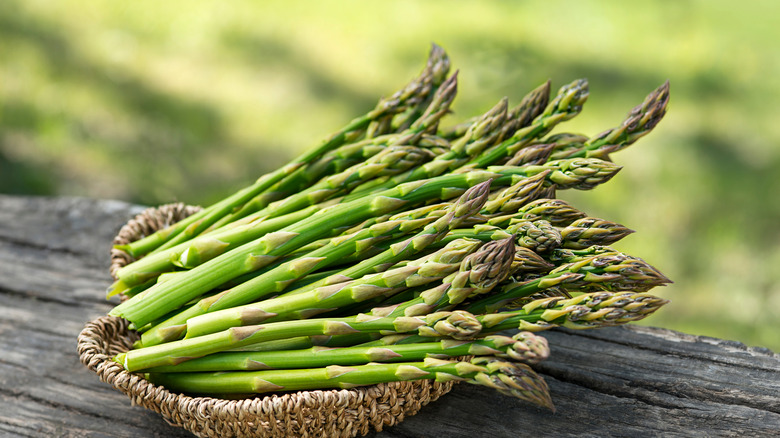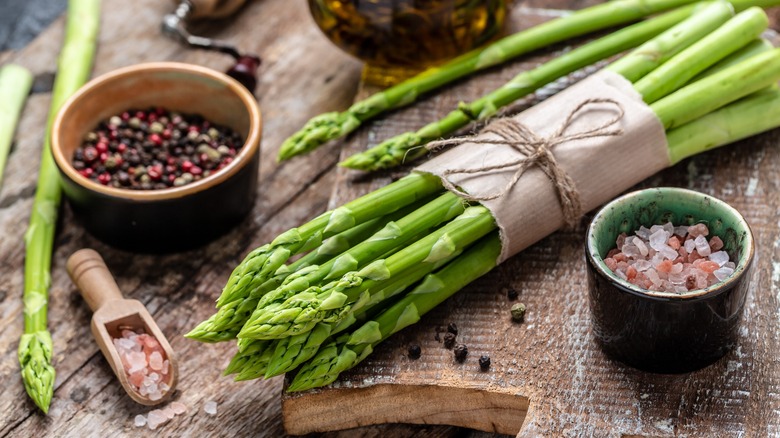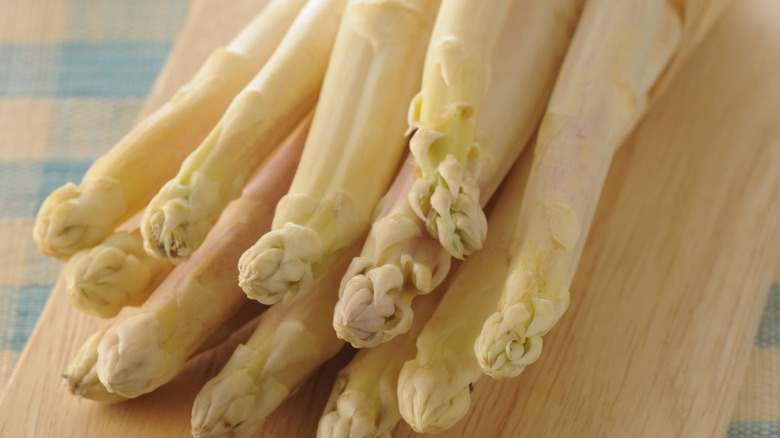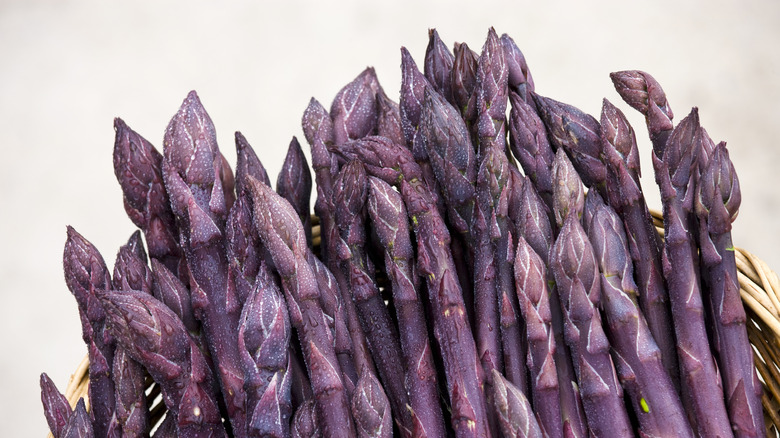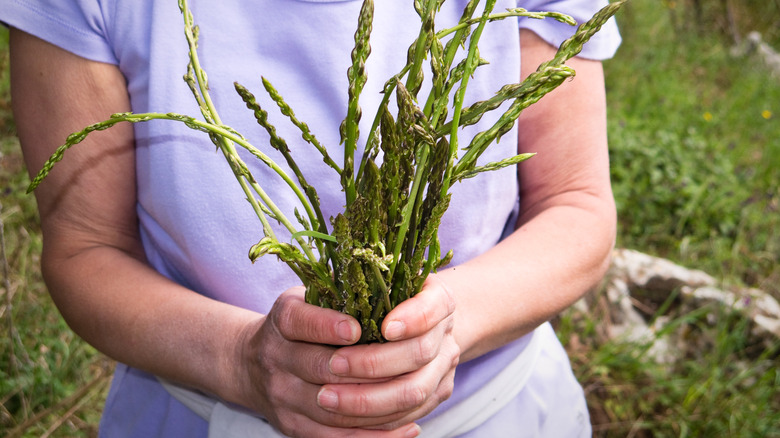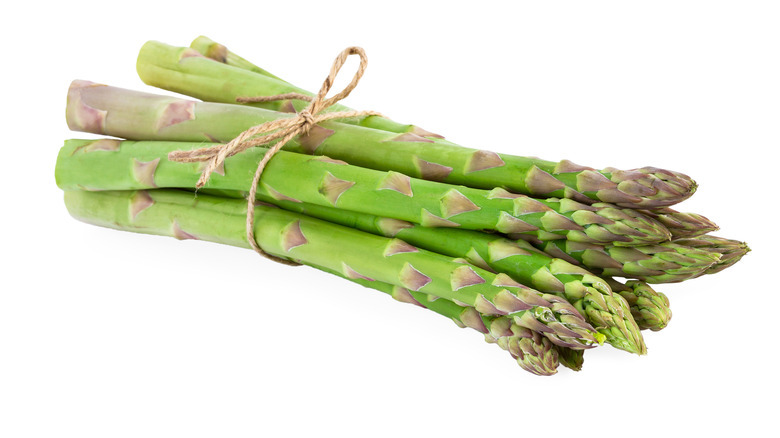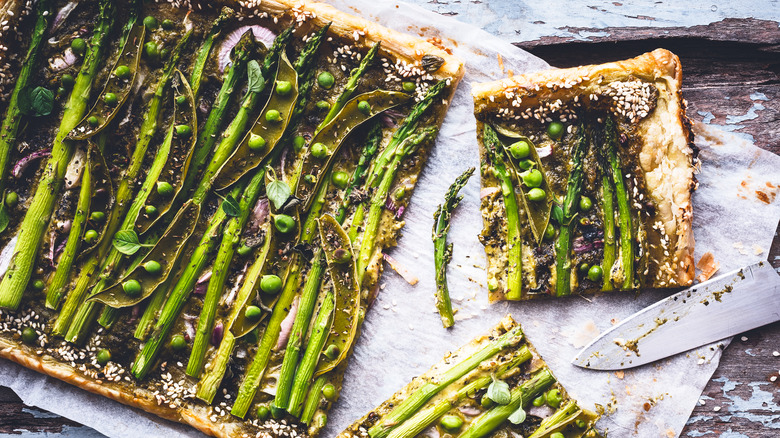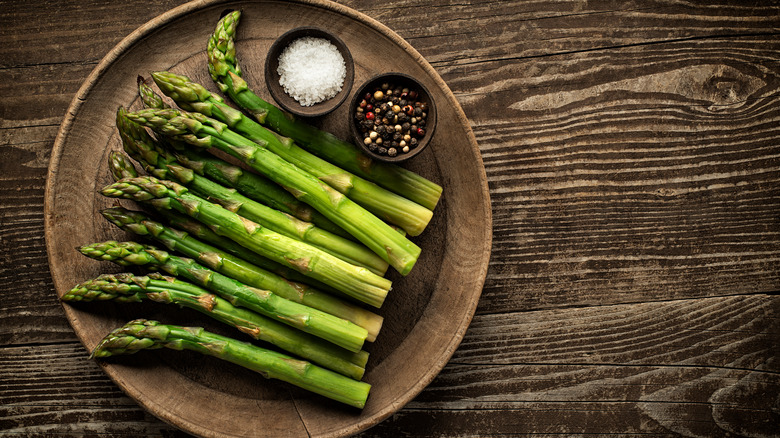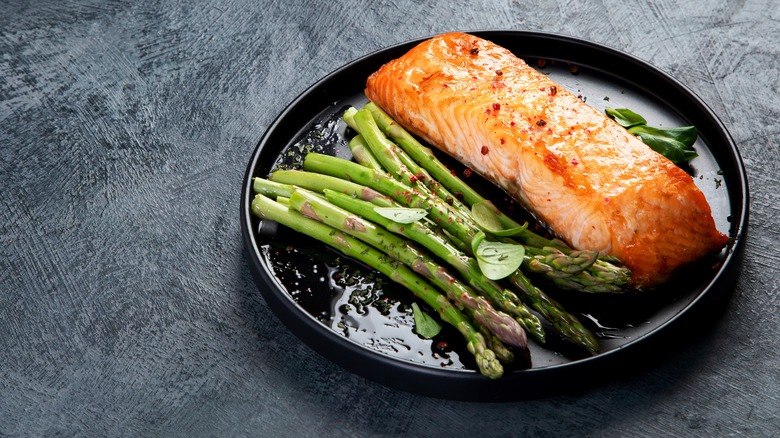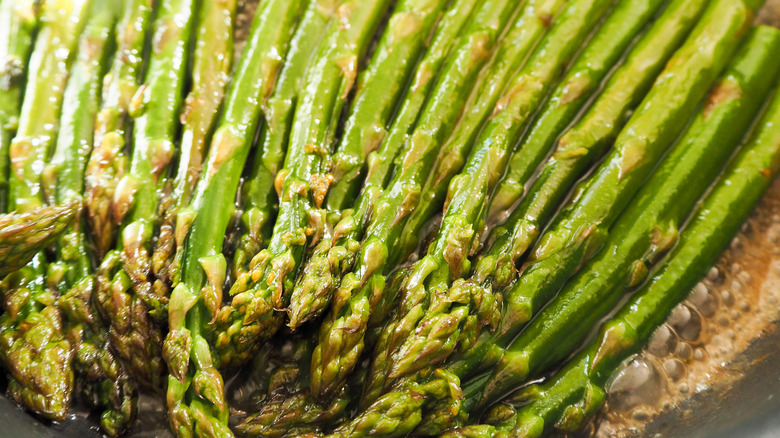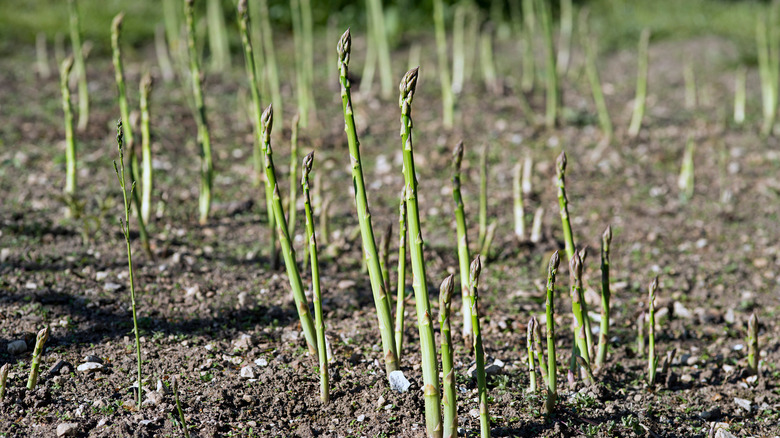10 Varieties Of Asparagus, Explained
Asparagus is a versatile, nutritious vegetable that can play almost any role in a meal, from a hearty main dish to a delicious side to a base for soups and salads. While many consumers are primarily familiar with the long, green spears typically sold in grocery stores, there are quite a few varieties of asparagus, each with unique attributes that make it conducive to particular meals.
But before getting to subtypes, let's talk a little about the vegetable as a whole. According to Encyclopedia Brittanica, over 300 species of asparagus (though some are only ornamental) exist. The plant returns every year, and a productive asparagus plot may last a decade or longer.
What you actually eat from an asparagus plant are the young shoots, notes PlantVillage at Penn State University. And, perhaps most notable of all, when it comes to eating, asparagus is highly nutritious, packed with calcium, magnesium, phosphorus, iron, and a host of other vitamins and minerals. Read on to learn a little more about these varieties of asparagus.
Green asparagus
Speaking generically, green asparagus is probably the most common type of this particular vegetable you will find in grocery stores, at farmers' markets, and even in individual garden plots. But being common is not bad, and much of the time, there is not necessarily any reason to go hunting for something beyond what you can find on the grocery store shelf. As detailed above, green asparagus is packed with nutrients, including vitamin B6, potassium, and vitamin C, in addition to others.
Its shoots arise early in the growing season, says PlantVillage, and as with pretty much any vegetable, it is always tastiest when it is most fresh. Green asparagus is highly versatile, and excellent for sautéing, grilling, pickling, making soups, and plenty more. Check out this simple roasted asparagus recipe for something that could easily double as a main dish or tasty side. For something a little more interesting, consider this cream of asparagus soup made with onion, garlic, potato, asparagus, and spices.
White asparagus
One of the principal differences between asparagus varieties in color is that perhaps nowhere is this more pronounced than with white asparagus. This apparently unique variety actually isn't so unique after all: All asparagus is technically "white" before it pops out of the soil and begins to photosynthesize with sunlight, per Michigan Asparagus. White asparagus is, for the most part, simply harvested before it surfaces. But there's more to the difference than just color. According to Specialty Produce, white asparagus is highly prized in certain regions, particularly in Europe.
When it comes to cooking, there is more to the difference than color. White asparagus tends to be tougher than green asparagus but has a milder taste. And finally, it's important to consider the cost: White asparagus is often harder to find and tends to be a little more expensive than typical green asparagus. But if you're interested in a culinary delicacy, give it a try!
Purple Passion asparagus
Purple Passion is one of the most popular "specialty" varieties of asparagus — and arguably one of the most aesthetically attractive types of the plant. As alluded by the name, this variety is vibrantly purple, its color coming from something called anthocyanins. Anthocyanins are a type of pigment, and in addition to imparting color to Purple Passion asparagus, anthocyanins also give color to berries, currents, and other fruits (per Food & Nutrition Research).
But it is not just color that makes this variety of asparagus especially unique. The high sugar content of purple passion asparagus makes the vegetable particularly sweet, and consequently (for both taste and aesthetic reasons) an interesting choice when you want to use raw asparagus (for instance, in salads). If you do decide to cook it, there is something to bear in mind: Like other fruits and vegetables with similar coloration, Purple Passion asparagus will change color, becoming greener when it's cooked.
Wild asparagus
Although perhaps less well-known these days, asparagus isn't only found in the grocery store or garden — it can also be foraged! Per Specialty Produce, wild asparagus can generally be found in late spring. The plant tends to be thinner than its cultivated counterpart, but is rich in flavor, and equally rich in vitamins and nutrients, containing potassium, vitamin C, fiber, and a whole host of other minerals. Of course, foraging takes a little know-how of its own.
According to the University of Wyoming Extension, wild asparagus likes to grow in sandy and moist soils and areas that are somewhat disturbed. Of course, it's important to know the laws around foraging, and be sure you're not trespassing as you look to harvest a good crop. But once you've found some, you can use it just like regular asparagus — you'll just want to keep in mind that the uncultivated spears tend not to be as fat.
Jersey Giant asparagus
There are a number of specialty subtypes of asparagus (coming in both green and in purple) — and one particularly reliable variety is the relatively new green hybrid, Jersey Giant asparagus. As the name suggests, Jersey Giant asparagus is big: It is a genetic hybrid and was designed specifically to produce large, robust spears. Uniquely, it is also an all-male hybrid, meaning that the plant does not have to waste energy and nutrients on producing seeds — instead, it can focus on getting large and plump for good eating.
This variety is also a good choice for beginning home gardeners: Per McKay Nursery Company, Jersey Giant asparagus grows well in the upper and middle parts of the United States, is extremely productive, and is fairly disease-resistant. Given the relative heft of these particular spears, Jersey Giant is a good choice for recipes that help to bring out the bulk of the plant — for instance, these baked asparagus fries.
Precoce D'Argenteuil asparagus
Looking for something a little more "upscale?" You could do worse than Precoce D'Argenteuil, an heirloom variety of asparagus that — as the name suggests — originated in France, (via CC Grow). It's an attractive variety of asparagus, with a spectrum of colors ranging from green to purple. According to Smart Gardener, it's considered particularly sweet and nutty and is more tender than traditional asparagus.
Its purple tips, as with purple passion asparagus, will become green as they cook. It's also an interesting variety to grow if you have garden space: As an heirloom, you can rest assured it has a long genetic history of sturdiness that makes it a prime choice for a home plot. Aside from its unique look and flavor, it is drought-resistant and frost tolerant, meaning it's more likely to survive even if you don't have a green thumb. Its sweeter, nuttier flavor lends it to plenty of delicate recipes that call for asparagus. If you're not sure where to begin, how about an asparagus and goat cheese tart?
Apollo asparagus
As far as variation goes, another interesting type of asparagus to look at is Apollo asparagus. But before discussing this particular variety, it may be worth recapping just what a hybrid is. Put simply, a hybrid variety of a plant is what results when a genetically unique plant is pollinated by a different variety of plants from the same class (via Iowa State University Extension). Hybridization can happen naturally, but when it comes to crops like asparagus, hybrids are generally produced intentionally, for reasons like disease resistance, size of spears, drought tolerance, and other attractive characteristics.
With that in mind, Apollo is an attractive hybrid for many reasons: It has the classic "green asparagus" look but with slightly purple tips, it is hardy in many climates, and it is fairly disease resistant, notes the Food Gardening Network. Its ease of growth makes it a good choice for new gardeners. And when it comes to eating, it's quite adaptable: Grilled asparagus with parmesan and honey mustard might be a good place to start.
Mary Washington asparagus
The asparagus plant is not originally native to North America. According to Encyclopedia Brittanica, its origins range from Siberia to Africa. That said, it has been popular in North America, and in the United States, for a long time — long enough, in fact, for heirloom varieties to grow in popularity in the U.S. One particularly popular variety, particularly for home gardeners, is Mary Washington asparagus.
The variety was originally bred by the United States Department of Agriculture's J. B. Norton in the early 1900s and has stayed popular for over a century. The variety is all-female, adds the Missouri Botanical Garden, and tends to produce particularly large stalks of asparagus, and its crop arrives earlier than other varieties. As with many other varieties surveyed here, Mary Washington asparagus is quite versatile. Are you looking for inspiration? For a well-rounded meal, consider searing it with fish and morel mushrooms.
Atlas asparagus
Continuing to examine the wide diversity of asparagus varieties, it is worth looking at another hybrid: Atlas asparagus. As indicated by the name, the variety called Atlas tends to produce large, mostly dark green spears (via Smart Gardener). Among other reasons for its popularity, it is especially resistant to Fusarium. (Fusarium, it is important to note, is, according to ScienceDirect, a fungi genus that causes disease for a wide variety of plants that includes, but is not limited to, asparagus).
The resistance that Atlas shows to Fusarium makes it particularly attractive to home cultivators, particularly those new to home gardening, and to growing asparagus. Atlas also has some other growing strengths: It is fairly cold hardy, as well as drought tolerant. And, of course, there's the taste. Smart Gardener describes Atlas as rich and nutty, making it a potentially perfect choice for this grilled asparagus with apricot and pine nut romesco.
Viking KB3 asparagus
The nice thing about plant cultivation — including with asparagus — is that new varieties continue to be developed all the time. Horticulturists work hard to breed new and diverse varieties of plants that are hardier, more drought tolerant, more resistant to disease, and overall stronger and more productive. If you are interested in trying out a choice new variety of asparagus, look out for (or try growing your own) Viking KB3 asparagus. Viking KB3 is actually a sub-type of the heirloom variety Mary Washington, and it was first created in Canada (per Country Folks Grower).
According to supplier Harris Seeds, Viking KB3 is also notable for producing substantial yields of asparagus. Finally, Viking KB3 is also a good choice if you are after a slightly thinner variety of asparagus, making it a fantastic choice for everything from pickled asparagus to sourdough avocado toast with poached egg and asparagus.
